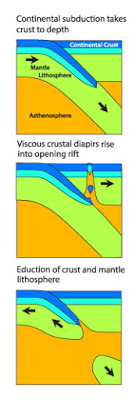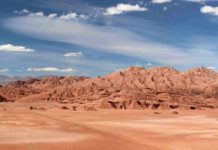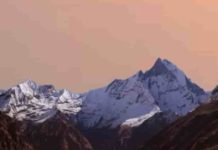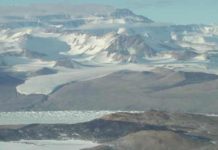In the D’Entrecasteaux Islands off Papua New Guinea, the rocks are giving rise to new ideas about the ways in which mountain chains form. A new scientific model inspired by data from the islands shows how the seemingly opposite processes of tectonic compression and extension can take place in the same region. It also shows how sections of earth’s crust that have been pushed deep under the surface can reverse course and rise in what in the geological time scale would be an instant. The model has implications for the understanding of how many mountain belts form.
The islands sit in the middle of an active, messy boundary between two major tectonic plates. Mountain belts like the Appalachians and the Alps formed in similar regions, where continental fragments, small ocean basins and island arcs smashed together.
In the last few decades, scientists have shown that rocks found in some mountain belts were formed at depths of 100 kilometers or more, where ultrahigh pressure minerals, like microdiamonds, form. It is accepted that continental rocks can get to that depth through subduction, when one plate is pushed under another.
There is an ongoing debate over how these rocks rise to the surface. Some argue that small bits of subducted crust break off and pop up to the surface either as brittle slivers or flowing “diapirs” (see illustration). Others argue that an entire plate that has been subducted can reverse course and rise back up, a process known as eduction.
The new thermomechanical model, created by scientists at Lamont‐Doherty Earth Observatory and Aarhus University in Denmark, shows how both processes can occur together. It shows that the most deeply subducted crust can be warmed enough for pieces to break off and flow upward into diapirs. The diapirs only move up a short distance, so something else has to transport them to the surface. In this case, the model shows how it is the reversal in direction of motion of the subducted slab. The model also shows how reverse subduction can be triggered by the start of a new subduction zone nearby.
The model came out of an effort to understand new observations made in and around the D’Entracasteaux Islands, the only known place on earth where ultrahigh-pressure rocks are actively coming up. The new work is described in the early online version of the journal Geochemistry, Geophysics, Geosystems. The model shows that continental extension and the spreading of new ocean basin can occur after the subducted plate is pulled up. This scenario is consistent with Woodlark Basin, which is actively spreading to the east of the islands.
Lamont geophysicist Roger Buck points to Goodenough Basin, just south of the islands, as a possible test of the reverse subduction model. On geologic time scales, the basin appears to be very new. It has little sediment, 50 to 1,000 meters, compared to 5 to 10 kilometers of sediment in areas around it. “Essentially, the islands may be the tip of what was brought down and warmed up and became partially molten. If the ultrahigh-pressure rocks on the islands had to be 100 kilometers down to form, what do you do with the top 90 kilometers when it comes up? I think it was continental margin that came back up and flattened and is now the floor of the Goodenough Basin,” Buck said.
Buck and Kenni Dinesen Peterson of Aarhaus University used computer models to show how resistance to subducting buoyant continental crust can trigger initiation of a new subduction zone. In the case of Goodenough Basin, the new subduction zone is the New Britain Trench. The model suggests that the floor of Goodenough Basin rose up within the past 5 million years. It’s a premise that could be tested in the future by drilling into the basin’s floor. This may help us figure out why many mountain belts have such a complex array of structures and rocks formed at different depths.
Reference:
“Eduction, extension, and exhumation of ultrahigh-pressure rocks in metamorphic core complexes due to subduction initiation.” Geochem. Geophys. Geosyst., 16, DOI: 10.1002/2015GC005847
Note: The above post is reprinted from materials provided by Columbia University.











